A Study on the Mechanisms Accounting for the Generation of a Southwest Vortex That Caused a Series of Severe Disasters during the 2020 Abnormal Meiyu Season
Abstract
1. Introduction
2. Data and Methods
2.1. Data
2.2. Methods
3. Overview of the Event and Synoptic Analyses
4. Main Results
4.1. Trajectory Analysis
4.2. Vorticity Budget ALONG Trajectories
4.3. Vorticity Budget within the Key Region
5. Conclusions and Discussion
Author Contributions
Funding
Institutional Review Board Statement
Informed Consent Statement
Data Availability Statement
Acknowledgments
Conflicts of Interest
References
- IPCC. Summary for Policymakers. In Climate Change 2013: The Physical Science Basis. Contribution of Working Group I to the Fifth Assessment Report of the Intergovernmental Panel on Climate Change; Cambridge University Press: Cambridge, UK; New York, NY, USA, 2013; p. 29. [Google Scholar]
- Song, L.C. Yearbook of Meteorological Disasters in China; China Meteorological Press: Beijing, China, 2018; p. 229. (In Chinese) [Google Scholar]
- Tao, S.Y. Rainstorms in China; Science Press: Beijing, China, 1980; p. 225. (In Chinese) [Google Scholar]
- Zhao, S.X.; Tao, Z.Y.; Sun, J.H.; Bei, N.F. Study on Mechanism of Formation and Development of Heavy Rainfalls on Meiyu Front in Yangtze River; China Meteorological Press: Beijing, China, 2004; p. 282. (In Chinese) [Google Scholar]
- Wei, K.; Ouyang, C.; Duan, H.; Li, Y.; Chen, M.; Ma, J.; An, H.; Zhou, S. Reflections on the catastrophic 2020 Yangtze River Basin flooding in Southern China. Innovation 2020, 1, 100038. [Google Scholar] [CrossRef]
- Ding, Y.H.; Liu, Y.Y.; Hu, Z.Z. The record-breaking Meiyu in 2020 and associated atmospheric circulation and tropical SST anomalies. Adv. Atmos. Sci. 2021. [Google Scholar] [CrossRef] [PubMed]
- Fu, S.M.; Zhang, J.P.; Tang, H.; Jiang, L.Z.; Sun, J.H. A new mesoscale-vortex identification metric: Restricted vorticity and its application. Environ. Res. Lett. 2020, 15, 124053. [Google Scholar] [CrossRef]
- Chen, T.; Zhang, F.; Yu, C.; Ma, J.; Zhang, X.D.; Shen, X.L.; Zhang, F.; Luo, Q. Synoptic analysis of extreme Meiyu precipitation over Yangtze River Basin during June-July 2020. Meteor. Mon. 2020, 46, 1415–1426. (In Chinese) [Google Scholar]
- Fu, S.M.; Yu, F.; Wang, D.H.; Xia, R.D. A comparison of two kinds of eastward-moving mesoscale vortices during the mei-yu period of 2010. Sci. China Earth Sci. 2013, 56, 282–300. [Google Scholar] [CrossRef]
- Fu, S.M.; Li, W.L.; Sun, J.H.; Zhang, Y.C. Universal evolution mechanisms and energy conversion characteristics of long-lived mesoscale vortices over the Sichuan Basin. Atmos. Sci. Lett. 2015, 16, 127–134. [Google Scholar] [CrossRef]
- Zhang, Y.C.; Fu, S.M.; Sun, J.H.; Fu, R.; Jin, S.L.; Ji, D.S. A 14-year statistics-based semi-idealized modeling study on the formation of a type of heavy rain–producing southwest vortex. Atmos. Sci. Lett. 2019, 2019, e894. [Google Scholar] [CrossRef]
- Feng, S.L.; Jin, S.L.; Fu, S.M.; Sun, J.H.; Zhang, Y.C. Formation of a kind of heavy-rain-producing mesoscale vortex around the Sichuan Basin: An along-track vorticity budget analysis. Atmos. Sci. Lett. 2019, 2019, e949. [Google Scholar] [CrossRef]
- Kuo, Y.; Cheng, L.; Bao, J. Numerical simulation of the 1981 Sichuan Flood. Part I: Evolution of a mesoscale southwest vortex. Mon. Weather Rev. 1988, 116, 2481–2504. [Google Scholar] [CrossRef]
- Zhao, P.; Hu, C.Q. Numerical simulation and diagnosis of the formation process of SW vortex. Chin. J. Atmos. Sci. 1992, 16, 177–184. (In Chinese) [Google Scholar]
- Chen, Z.M.; Xu, M.L.; Min, W.B.; Miu, Q. Relationship between abnormal activities of southwest vortex and heavy rain the upper reach of Yangtze River during summer of 1998. Plateau Meteorol. 2003, 22, 162–167. [Google Scholar]
- Zhao, S.X.; Fu, S.M. An analysis on the southwest vortex and its environment fields during heavy rainfall in eastern Sichuan Province and Chongqing in September 2004. Chin. J. Atmos. Sci. 2007, 31, 1059–1075. [Google Scholar]
- Fu, S.M.; Sun, J.H.; Zhao, S.X.; Li, W.L. The energy budget of a southwest vortex with heavy rainfall over South China. Adv. Atmos. Sci. 2011, 3, 709–724. [Google Scholar] [CrossRef]
- Wang, Q.W.; Tan, Z.M. Multi-scale topographic control of southwest vortex formation in Tibetan Plateau region in an idealized simulation. J. Geophys. Res. Atmos. 2014, 119, 11543–11561. [Google Scholar] [CrossRef]
- Zhang, J.P.; Fu, S.M.; Sun, J.H.; Shen, X.Y.; Zhang, Y.C. A statistical and compositional study on the two types of mesoscale vortices over the Yangtze River basin. Clim. Environ. Res. 2015, 20, 319–336. (In Chinese) [Google Scholar]
- Hans, H.; Bill, B.; Paul, B.; Shoji, H.; Jeankmol, T. The ERA5 global reanalysis. Q. J. R. Meteorol. Soc. 2020, 146, 1999–2049. [Google Scholar]
- Stein, A.F.; Draxler, R.R.; Rolph, G.D.; Stunder, B.J.B.; Cohen, M.D.; Ngan, F. NOAA’S HYSPLIT atmospheric transport and dispersion modeling system. Bull. Am. Meteor. Soc. 2015, 96, 2059–2077. [Google Scholar] [CrossRef]
- Holton, J.R. An Introduction to Dynamic Meteorology; Academic Press: San Diego, CA, USA, 2004. [Google Scholar]
- Markowski, P.; Richardson, Y. Mesoscale Meteorology in Midlatitudes; Wiley-Blackwell: Hoboken, NJ, USA, 2010; p. 407. [Google Scholar]
- Fu, S.M.; Zhang, J.P.; Sun, J.H.; Zhao, T.B. Composite analysis of long-lived mesoscale vortices over the middle reaches of the Yangtze River valley: Octant features and evolution mechanisms. J. Clim. 2016, 29, 761–781. [Google Scholar] [CrossRef]
- Tang, H.; Fu, S.M.; Sun, J.H.; Mai, Z.; Jin, S.L.; Zhang, Y.C. Investigation of severe precipitation event caused by an eastward-propagating MCS originating from the Tibetan Plateau and a downstream southwest vortex. Chin. J. Atmos. Sci. 2020, 44, 1275–1290. (In Chinese) [Google Scholar]
- Liu, B.Q.; Yan, Y.H.; Zhu, C.W.; Ma, S.M.; Li, J.Y. Record breaking Meiyu rainfall around Yangtze River in 2020 regulated by the subseasonal phase transition of North Atlantic Oscillation. Geophys. Res. Lett. 2020, 47, e2020GL090342. [Google Scholar] [CrossRef]
- Fu, S.-M.; Tang, H.; Li, Y.; Ma, H.; Sun, J.-H. On the Relationship of a Low-Level Jet and the Formation of a Heavy-Rainfall-Producing Mesoscale Vortex over the Yangtze River Basin. Atmosphere 2021, 12, 156. [Google Scholar] [CrossRef]
- Mansell, E.R.; Ziegler, C.L. Aerosol effects on simulated storm electrification and precipitation in a two-moment bulk microphysics model. J. Atmos. Sci. 2013, 70, 2032–2050. [Google Scholar] [CrossRef]
- Wang, C. A modeling study of the response of tropical deep convection to the increase of cloud condensation nuclei concentration: 1. Dynamics and microphysics. J. Geophys. Res. 2005, 110, D21211. [Google Scholar] [CrossRef]
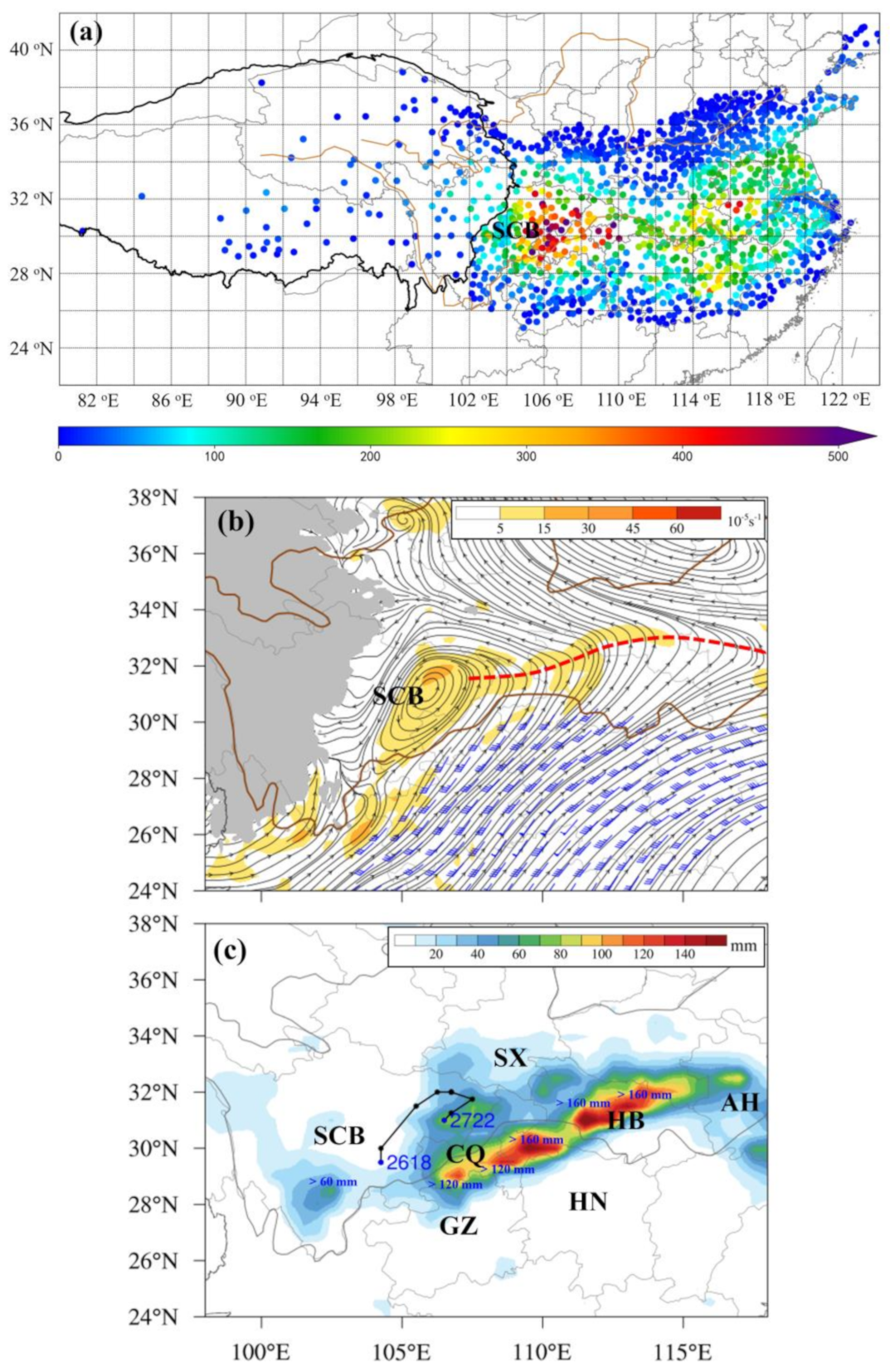
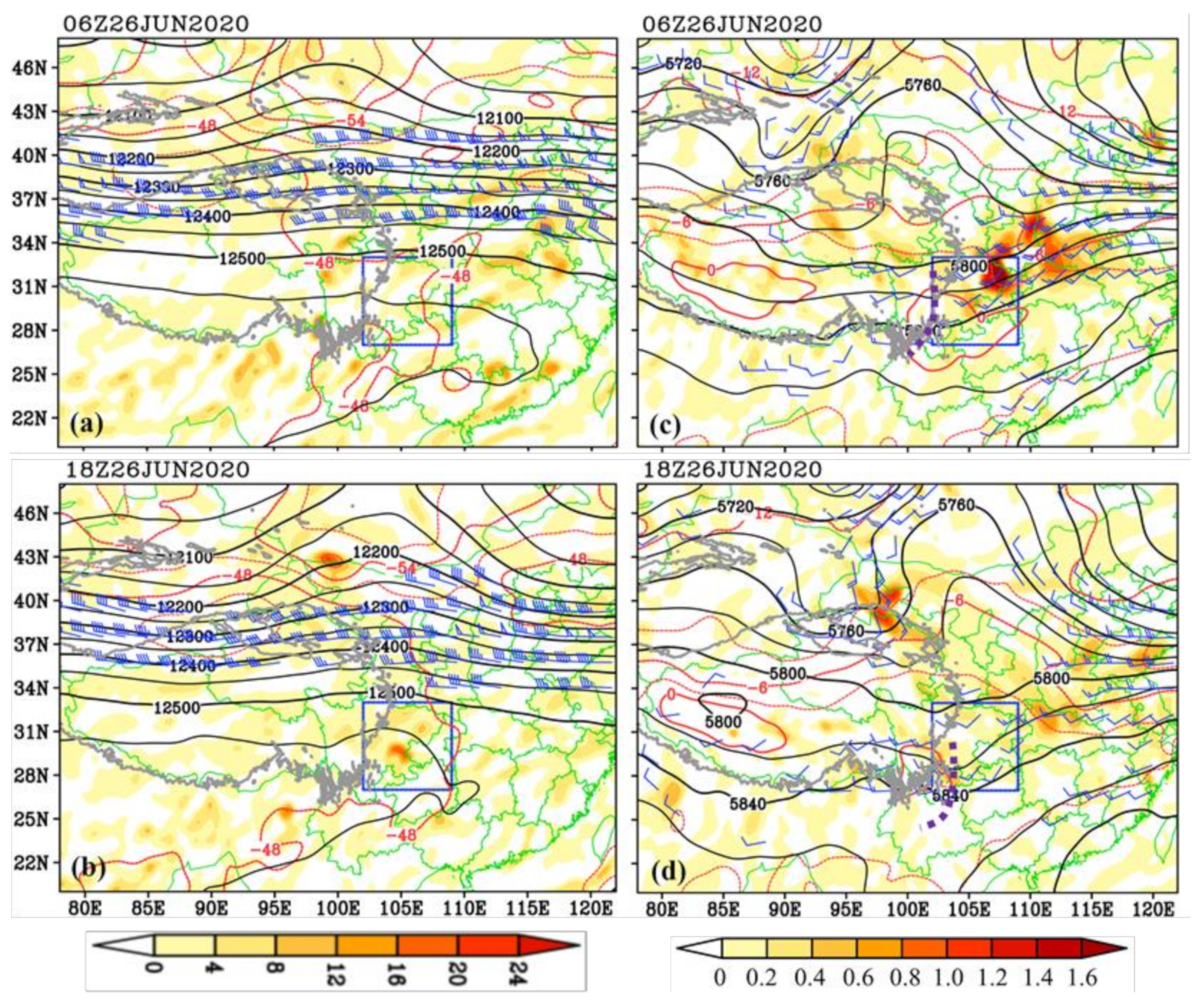

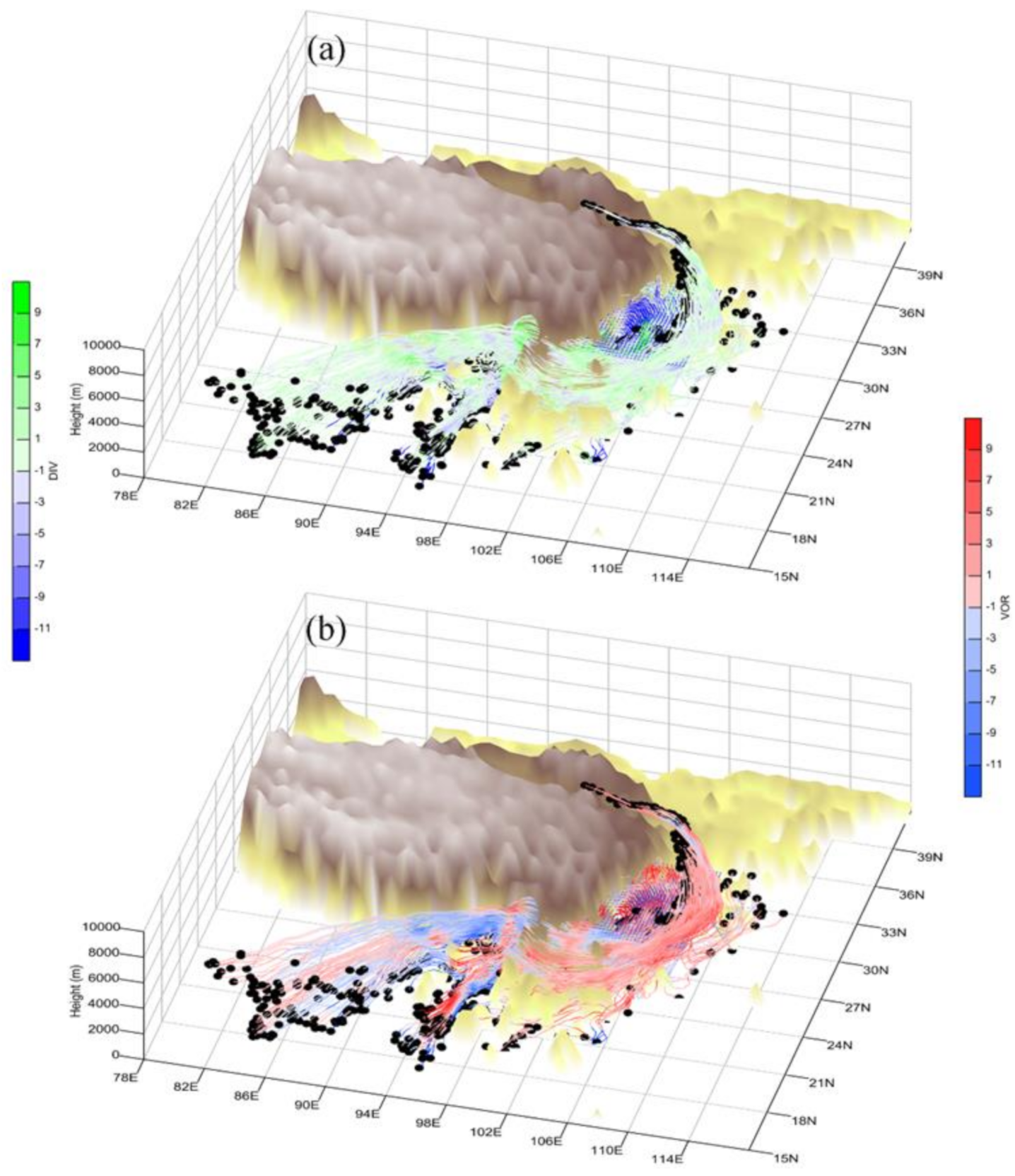
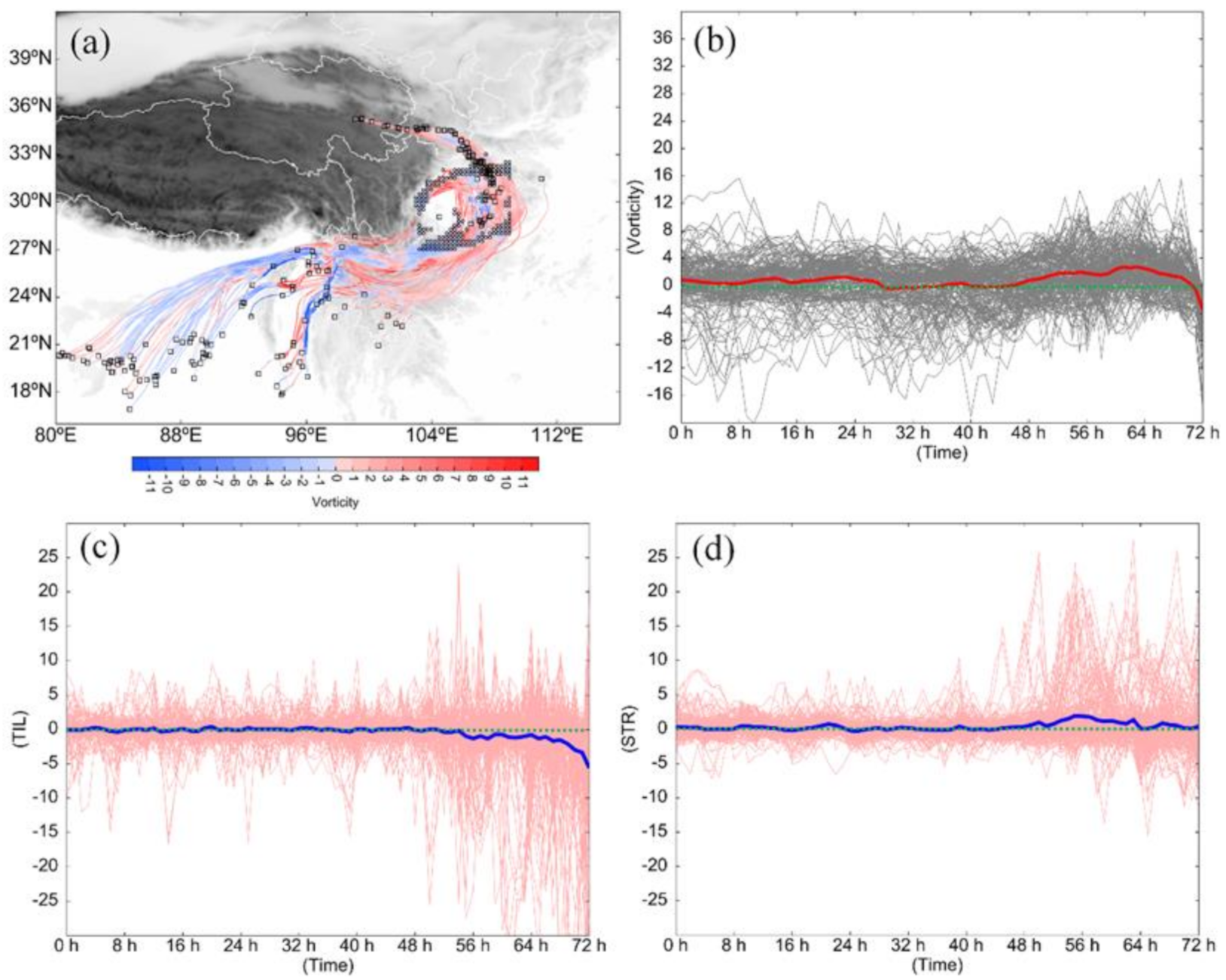
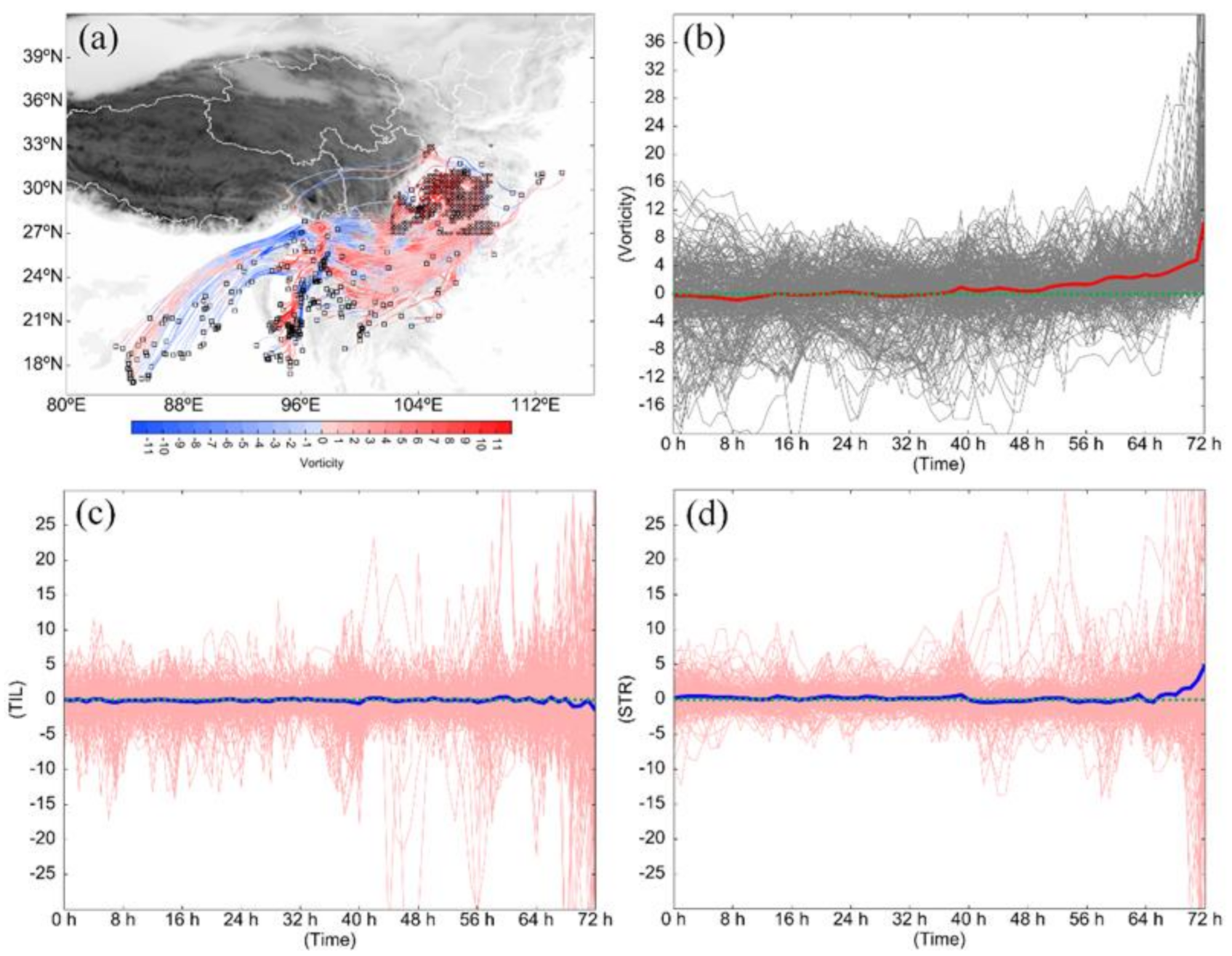
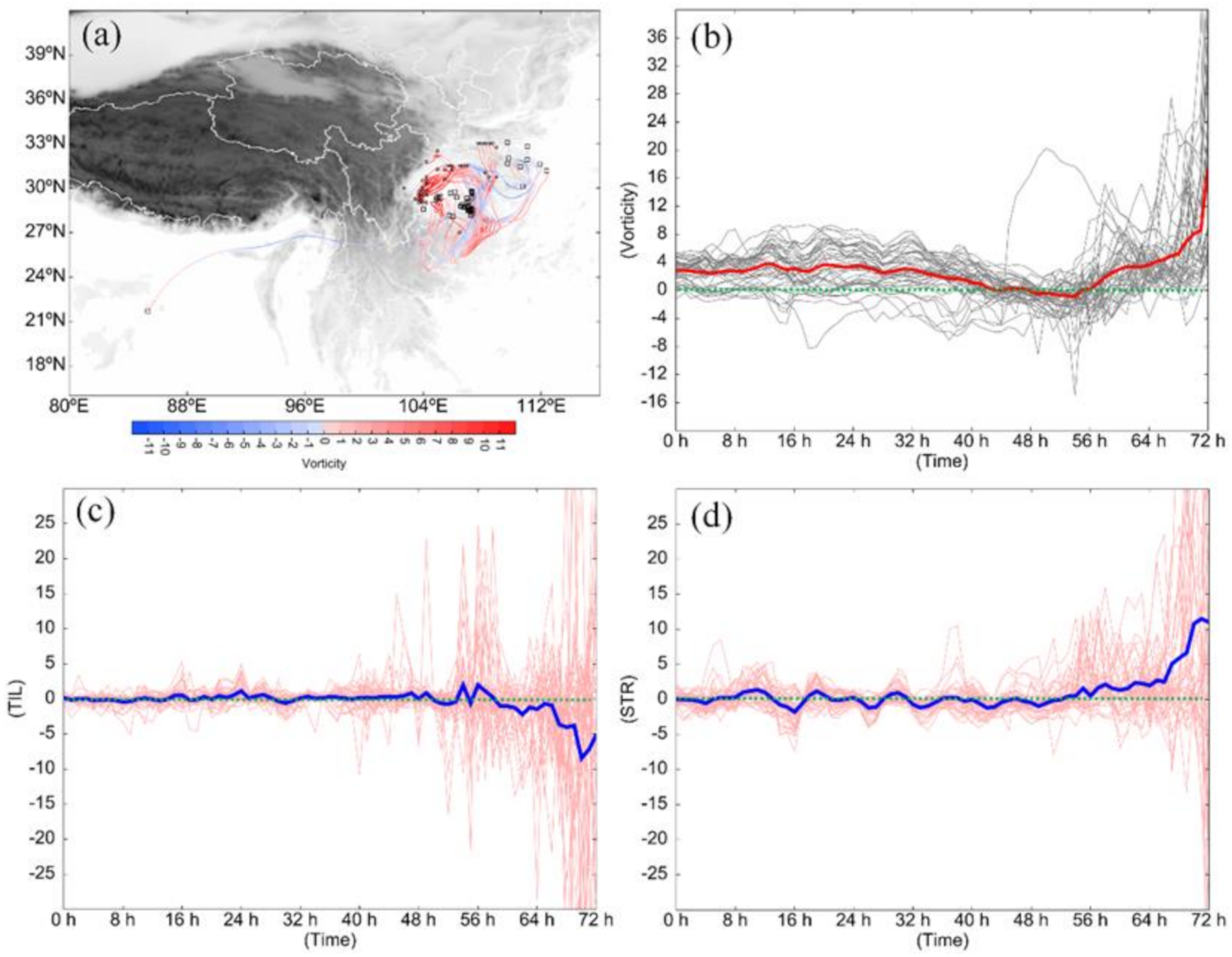
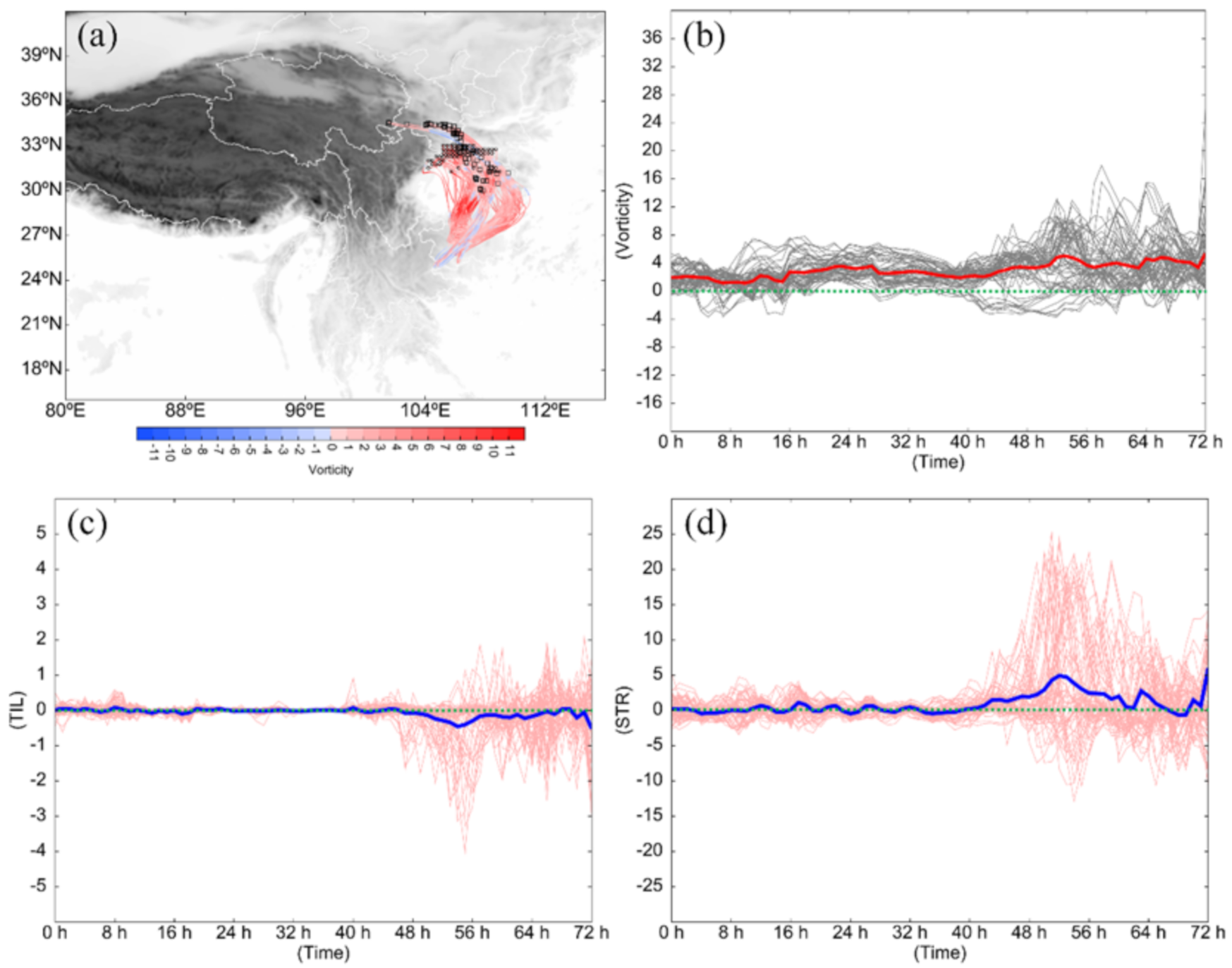
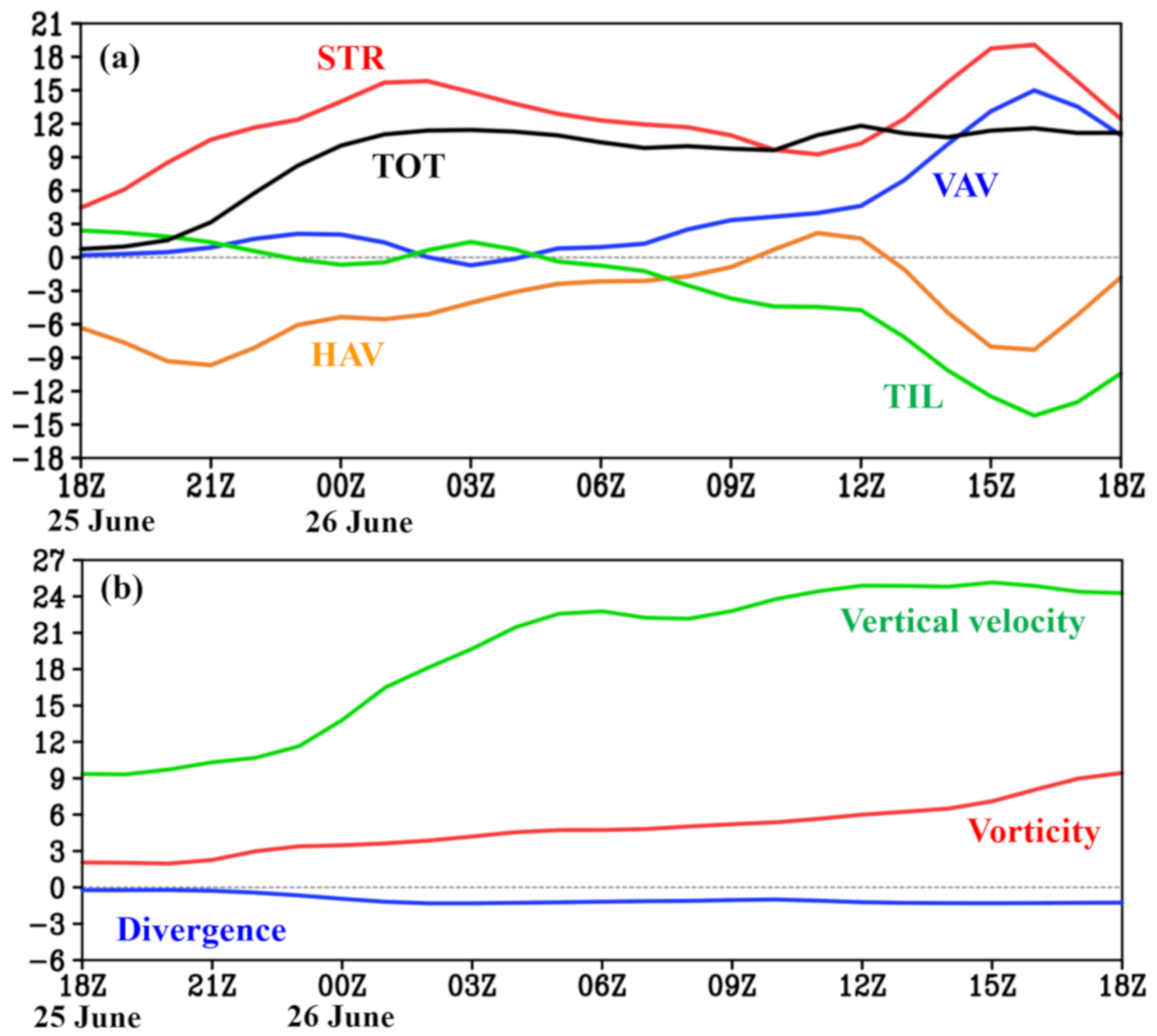
| Features | NEG | POS-LAB | POS-LSM | POS-LBE |
|---|---|---|---|---|
| Proportion in number | 33.0% | 10.7% | 7.1% | 49.1% |
| Proportion in final vorticity | −20.2% | 10.1% | 21.8% | 88.3% |
| Mean vorticity change | −4.4 | +3.4 | +14.7 | +13.3 |
| Mean divergence change | +1.7 | −1.4 | −6.5 | −5.8 |
| Mean height change | 141 m | −1873 m | 98 m | 1825 m |
Publisher’s Note: MDPI stays neutral with regard to jurisdictional claims in published maps and institutional affiliations. |
© 2021 by the authors. Licensee MDPI, Basel, Switzerland. This article is an open access article distributed under the terms and conditions of the Creative Commons Attribution (CC BY) license (https://creativecommons.org/licenses/by/4.0/).
Share and Cite
Ma, H.; Ma, X.; Jing, Y.; Wu, G. A Study on the Mechanisms Accounting for the Generation of a Southwest Vortex That Caused a Series of Severe Disasters during the 2020 Abnormal Meiyu Season. Atmosphere 2021, 12, 556. https://doi.org/10.3390/atmos12050556
Ma H, Ma X, Jing Y, Wu G. A Study on the Mechanisms Accounting for the Generation of a Southwest Vortex That Caused a Series of Severe Disasters during the 2020 Abnormal Meiyu Season. Atmosphere. 2021; 12(5):556. https://doi.org/10.3390/atmos12050556
Chicago/Turabian StyleMa, Hui, Xiaolei Ma, Yanwei Jing, and Guiping Wu. 2021. "A Study on the Mechanisms Accounting for the Generation of a Southwest Vortex That Caused a Series of Severe Disasters during the 2020 Abnormal Meiyu Season" Atmosphere 12, no. 5: 556. https://doi.org/10.3390/atmos12050556
APA StyleMa, H., Ma, X., Jing, Y., & Wu, G. (2021). A Study on the Mechanisms Accounting for the Generation of a Southwest Vortex That Caused a Series of Severe Disasters during the 2020 Abnormal Meiyu Season. Atmosphere, 12(5), 556. https://doi.org/10.3390/atmos12050556







